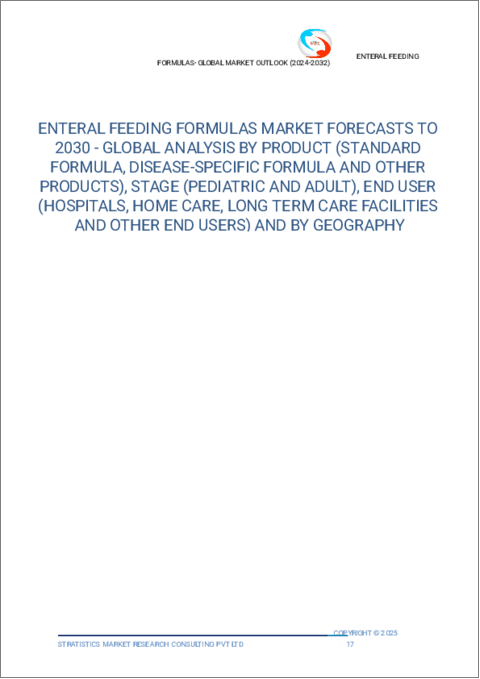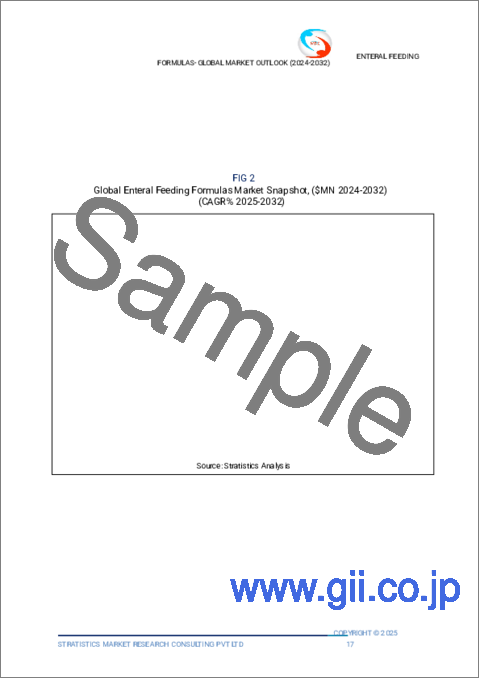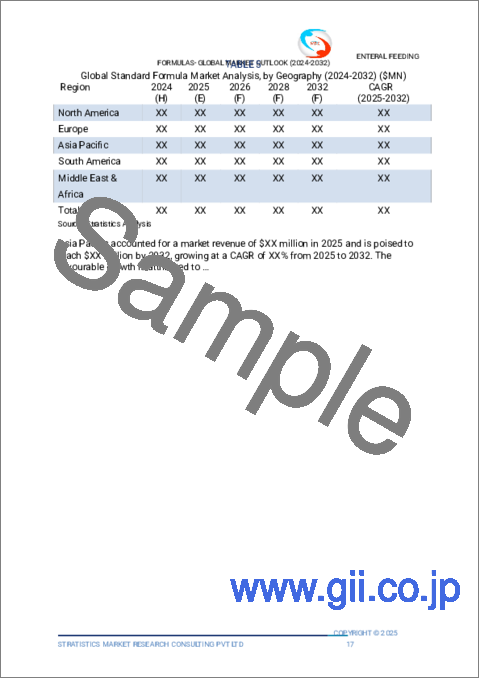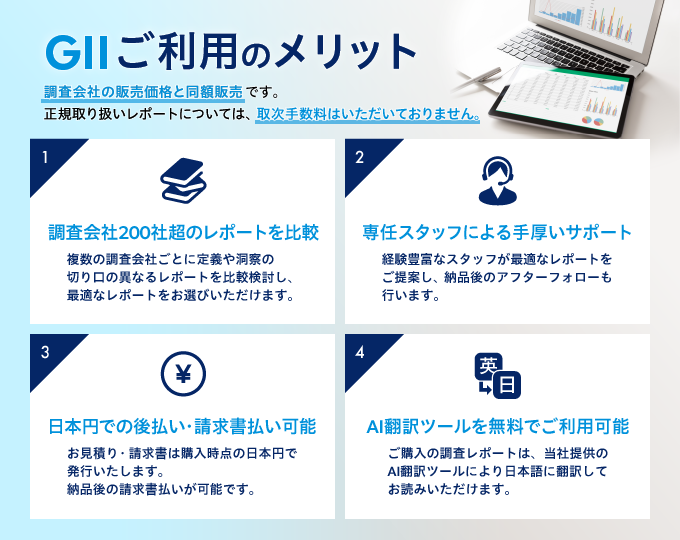|
|
市場調査レポート
商品コード
1476368
経腸栄養剤市場の2030年までの予測:製品別、ステージ別、エンドユーザー別、地域別の世界分析Enteral Feeding Formulas Market Forecasts to 2030 - Global Analysis By Product, Stage, End User and By Geography |
||||||
カスタマイズ可能
|
|||||||
| 経腸栄養剤市場の2030年までの予測:製品別、ステージ別、エンドユーザー別、地域別の世界分析 |
|
出版日: 2024年05月05日
発行: Stratistics Market Research Consulting
ページ情報: 英文 200+ Pages
納期: 2~3営業日
|
全表示
- 概要
- 図表
- 目次
Stratistics MRCによると、経腸栄養剤の世界市場は2023年に58億米ドルを占め、予測期間中にCAGR 11.7%で成長し、2030年には126億米ドルに達する見込みです。
経腸栄養剤市場には、経口摂取が困難な人の栄養ニーズを満たすために設計されたさまざまな特殊液体栄養製品が含まれます。これらのフォーミュラは、口腔をバイパスして、栄養チューブを通して消化管に直接投与されます。経腸栄養剤市場は、高齢者、重篤な病人、障害者など、さまざまな患者に対応しています。
IDF 2021によると、約5億3,700万人の成人が糖尿病を患っており、2030年には6億4,300万人、2045年には7億8,300万人に増加すると予測されています。
慢性疾患の増加
がん、胃腸障害、神経障害などの疾患が世界的に流行するにつれて、経腸栄養ソリューションに対する需要が高まっています。これらの疾患により、患者は固形食の嚥下や消化が困難になることが多く、経腸栄養のような代替栄養補給方法が必要となります。経腸栄養剤は、経口経路を迂回して必要な栄養素を消化管に直接供給する便利で効果的な方法を提供します。
特殊な処方はコストが高い
経腸栄養剤は、胃腸障害、代謝性疾患、手術後の回復期など、特定の病状や食事条件を持つ人の栄養ニーズを満たすように調整されています。しかし、これらの専用フォーミュラは法外な価格であるため、多くの患者には経済的に手が届かず、需要の減少や市場拡大の妨げとなっています。しかし、ヘルスケア施設や保険会社は予算の制約に直面することが多く、必要な患者にこうした高価な製剤を調達する能力をさらに制限しています。
栄養不良の蔓延
栄養不良は世界的に広範な問題であり、慢性疾患、人口の高齢化、不十分な食事摂取などの要因により、さまざまな年齢層の個人に影響を及ぼしています。経腸栄養剤は、経口的に食物を摂取したり、栄養素を効果的に吸収したりすることができない人々に、必要な栄養素を直接供給するための重要な解決策を提供します。ヘルスケアにおける栄養の重要性に対する認識が高まり、医療技術の進歩や医療費の増加も相まって、経腸栄養剤の需要は増加傾向にあります。
経腸栄養剤に対する患者の認識不足と不十分な払い戻し
経腸栄養サポートを必要とする患者の多くは、適切な栄養補給の重要性や、患者のニーズに合わせた特殊な製剤の利用可能性を十分に理解していない可能性があります。こうした認識不足は経腸栄養製品の利用不足につながり、市場の成長を阻害します。経腸栄養剤に対する十分な払い戻しが、経腸栄養剤市場の大きな妨げとなっています。経腸栄養は、経口摂取が困難な患者に対する医療の重要な要素であり、ヘルスケアシステムや保険業者からの償還に大きく依存しています。
COVID-19の影響:
世界のサプライチェーンの混乱により、これらの処方の製造に不可欠な原材料や成分が不足し、生産の遅れやサプライチェーンの制約が生じた。封鎖措置や必要でない医療処置の制限により、入院や選択的手術が減少し、経腸栄養補給を必要とする患者数の減少につながった。しかし、ヘルスケアシステムがパンデミックに適応し、延期された処置の滞留に対処し始めたため、経腸栄養剤の需要は、将来のウイルスの波やヘルスケアサービスへの潜在的な混乱に関する不確実性は継続するもの、徐々に回復した可能性があります。
予測期間中、疾患別ミルク部門が最大となる見込み
疾患特異的フォーミュラは、さまざまな病状の患者特有の栄養ニーズに対応することで、予測期間中に最大となる見込みです。これらの疾患特異的フォーミュラは、糖尿病、がん、胃腸障害、腎不全などの疾患を患う患者特有の食事要件に対応するように処方されます。オーダーメイドの栄養を提供することで、これらのフォーミュラは患者の転帰を最適化し、より早い回復を促し、全体的な健康管理を改善します。
長期介護施設セグメントは予測期間中最も高いCAGRが見込まれる
長期療養施設分野は、予測期間中に最も高いCAGRが見込まれます。LTCFは慢性疾患、障害、経口摂取が困難な人々を対象としているため、これらの施設内での経腸栄養剤の需要は常に高いです。このような施設には、嚥下障害、認知症、脳卒中などの症状を持つ高齢者が入居していることが多く、そのような高齢者は個別の栄養サポートを必要とします。その結果、LTCFは経腸栄養剤の開発と技術革新を推進する重要な市場セグメントとなっており、メーカー各社はこの層特有の栄養ニーズや嗜好に対応するための研究開発に投資しています。
最大のシェアを占める地域
推定期間中、アジア太平洋地域が市場で最大のシェアを占めました。早産児は消化器系が未発達であるため、専門的な栄養補給を必要とすることが多く、経腸栄養用調製粉乳はそのケアに不可欠な要素となっています。早産児の増加に伴い、この地域では未熟児特有のニーズに合わせた高品質で栄養豊富な経腸栄養剤の需要が高まっています。このような需要の急増により、ヘルスケアプロバイダーや施設は経腸栄養剤を大量に調達するようになり、地域の成長を牽引しています。
CAGRが最も高い地域:
欧州地域は予測期間中、収益性の高い成長を維持する見込みです。欧州食品安全機関(EFSA)や欧州医薬品庁(EMA)などの厳しい規制枠組みが、経腸栄養剤の製造、表示、流通の基準を定めています。これらの規制は、徹底的な試験、成分の透明性、特定の栄養ガイドラインの遵守を義務付けています。さらに、欧州政府が経腸栄養剤に対して実施している償還政策は、必要としている患者のアクセスを容易にすることで、市場の成長をさらに刺激しています。
無料のカスタマイズサービス:
本レポートをご購読のお客様には、以下の無料カスタマイズオプションのいずれかをご利用いただけます:
- 企業プロファイル
- 追加市場プレイヤーの包括的プロファイリング(3社まで)
- 主要企業のSWOT分析(3社まで)
- 地域セグメンテーション
- 顧客の関心に応じた主要国の市場推計・予測・CAGR(注:フィージビリティチェックによる)
- 競合ベンチマーキング
- 製品ポートフォリオ、地理的プレゼンス、戦略的提携に基づく主要企業のベンチマーキング
目次
第1章 エグゼクティブサマリー
第2章 序文
- 概要
- ステークホルダー
- 調査範囲
- 調査手法
- データマイニング
- データ分析
- データ検証
- 調査アプローチ
- 調査情報源
- 1次調査情報源
- 2次調査情報源
- 前提条件
第3章 市場動向分析
- 促進要因
- 抑制要因
- 機会
- 脅威
- 製品分析
- エンドユーザー分析
- 新興市場
- COVID-19の影響
第4章 ポーターのファイブフォース分析
- 供給企業の交渉力
- 買い手の交渉力
- 代替品の脅威
- 新規参入業者の脅威
- 競争企業間の敵対関係
第5章 世界の経腸栄養剤市場:製品別
- 標準式
- 疾患別の処方
- アルツハイマー病
- がん治療
- 吸収不良
- 糖尿病
- 希少疾患
- 慢性腎臓病
- その他の製品
第6章 世界の経腸栄養剤市場:ステージ別
- 小児
- 成人
第7章 世界の経腸栄養剤市場:エンドユーザー別
- 病院
- 在宅ケア
- 長期ケア施設
- その他のエンドユーザー
第8章 世界の経腸栄養剤市場:地域別
- 北米
- 米国
- カナダ
- メキシコ
- 欧州
- ドイツ
- 英国
- イタリア
- フランス
- スペイン
- その他欧州
- アジア太平洋地域
- 日本
- 中国
- インド
- オーストラリア
- ニュージーランド
- 韓国
- その他アジア太平洋地域
- 南米
- アルゼンチン
- ブラジル
- チリ
- その他南米
- 中東・アフリカ
- サウジアラビア
- アラブ首長国連邦
- カタール
- 南アフリカ
- その他中東とアフリカ
第9章 主な発展
- 契約、パートナーシップ、コラボレーション、合弁事業
- 買収と合併
- 新製品発売
- 事業拡大
- その他の主要戦略
第10章 企業プロファイリング
- Danone S.A
- Primus Pharmaceuticals, Inc
- Fresenius Kabi AG
- Meiji Holdings. Co., Ltd
- Abbott
- Hormel Foods Corporation
- Mead Johnson & Company, LLC
- Nestle
- B. Braun Melsungen AG
- Nutritional Medicinals, LLC
- Medtrition Inc
- DermaRite Industries, LLC
List of Tables
- Table 1 Global Enteral Feeding Formulas Market Outlook, By Region (2021-2030) ($MN)
- Table 2 Global Enteral Feeding Formulas Market Outlook, By Product (2021-2030) ($MN)
- Table 3 Global Enteral Feeding Formulas Market Outlook, By Standard Formula (2021-2030) ($MN)
- Table 4 Global Enteral Feeding Formulas Market Outlook, By Disease-specific Formula (2021-2030) ($MN)
- Table 5 Global Enteral Feeding Formulas Market Outlook, By Alzheimer's Disease (2021-2030) ($MN)
- Table 6 Global Enteral Feeding Formulas Market Outlook, By Cancer Care (2021-2030) ($MN)
- Table 7 Global Enteral Feeding Formulas Market Outlook, By Malabsorption (2021-2030) ($MN)
- Table 8 Global Enteral Feeding Formulas Market Outlook, By Diabetes (2021-2030) ($MN)
- Table 9 Global Enteral Feeding Formulas Market Outlook, By Orphan Diseases (2021-2030) ($MN)
- Table 10 Global Enteral Feeding Formulas Market Outlook, By Chronic Kidney Diseases (2021-2030) ($MN)
- Table 11 Global Enteral Feeding Formulas Market Outlook, By Other Products (2021-2030) ($MN)
- Table 12 Global Enteral Feeding Formulas Market Outlook, By Stage (2021-2030) ($MN)
- Table 13 Global Enteral Feeding Formulas Market Outlook, By Pediatric (2021-2030) ($MN)
- Table 14 Global Enteral Feeding Formulas Market Outlook, By Adult (2021-2030) ($MN)
- Table 15 Global Enteral Feeding Formulas Market Outlook, By End User (2021-2030) ($MN)
- Table 16 Global Enteral Feeding Formulas Market Outlook, By Hospitals (2021-2030) ($MN)
- Table 17 Global Enteral Feeding Formulas Market Outlook, By Home Care (2021-2030) ($MN)
- Table 18 Global Enteral Feeding Formulas Market Outlook, By Long Term Care Facilities (2021-2030) ($MN)
- Table 19 Global Enteral Feeding Formulas Market Outlook, By Other End Users (2021-2030) ($MN)
- Table 20 North America Enteral Feeding Formulas Market Outlook, By Country (2021-2030) ($MN)
- Table 21 North America Enteral Feeding Formulas Market Outlook, By Product (2021-2030) ($MN)
- Table 22 North America Enteral Feeding Formulas Market Outlook, By Standard Formula (2021-2030) ($MN)
- Table 23 North America Enteral Feeding Formulas Market Outlook, By Disease-specific Formula (2021-2030) ($MN)
- Table 24 North America Enteral Feeding Formulas Market Outlook, By Alzheimer's Disease (2021-2030) ($MN)
- Table 25 North America Enteral Feeding Formulas Market Outlook, By Cancer Care (2021-2030) ($MN)
- Table 26 North America Enteral Feeding Formulas Market Outlook, By Malabsorption (2021-2030) ($MN)
- Table 27 North America Enteral Feeding Formulas Market Outlook, By Diabetes (2021-2030) ($MN)
- Table 28 North America Enteral Feeding Formulas Market Outlook, By Orphan Diseases (2021-2030) ($MN)
- Table 29 North America Enteral Feeding Formulas Market Outlook, By Chronic Kidney Diseases (2021-2030) ($MN)
- Table 30 North America Enteral Feeding Formulas Market Outlook, By Other Products (2021-2030) ($MN)
- Table 31 North America Enteral Feeding Formulas Market Outlook, By Stage (2021-2030) ($MN)
- Table 32 North America Enteral Feeding Formulas Market Outlook, By Pediatric (2021-2030) ($MN)
- Table 33 North America Enteral Feeding Formulas Market Outlook, By Adult (2021-2030) ($MN)
- Table 34 North America Enteral Feeding Formulas Market Outlook, By End User (2021-2030) ($MN)
- Table 35 North America Enteral Feeding Formulas Market Outlook, By Hospitals (2021-2030) ($MN)
- Table 36 North America Enteral Feeding Formulas Market Outlook, By Home Care (2021-2030) ($MN)
- Table 37 North America Enteral Feeding Formulas Market Outlook, By Long Term Care Facilities (2021-2030) ($MN)
- Table 38 North America Enteral Feeding Formulas Market Outlook, By Other End Users (2021-2030) ($MN)
- Table 39 Europe Enteral Feeding Formulas Market Outlook, By Country (2021-2030) ($MN)
- Table 40 Europe Enteral Feeding Formulas Market Outlook, By Product (2021-2030) ($MN)
- Table 41 Europe Enteral Feeding Formulas Market Outlook, By Standard Formula (2021-2030) ($MN)
- Table 42 Europe Enteral Feeding Formulas Market Outlook, By Disease-specific Formula (2021-2030) ($MN)
- Table 43 Europe Enteral Feeding Formulas Market Outlook, By Alzheimer's Disease (2021-2030) ($MN)
- Table 44 Europe Enteral Feeding Formulas Market Outlook, By Cancer Care (2021-2030) ($MN)
- Table 45 Europe Enteral Feeding Formulas Market Outlook, By Malabsorption (2021-2030) ($MN)
- Table 46 Europe Enteral Feeding Formulas Market Outlook, By Diabetes (2021-2030) ($MN)
- Table 47 Europe Enteral Feeding Formulas Market Outlook, By Orphan Diseases (2021-2030) ($MN)
- Table 48 Europe Enteral Feeding Formulas Market Outlook, By Chronic Kidney Diseases (2021-2030) ($MN)
- Table 49 Europe Enteral Feeding Formulas Market Outlook, By Other Products (2021-2030) ($MN)
- Table 50 Europe Enteral Feeding Formulas Market Outlook, By Stage (2021-2030) ($MN)
- Table 51 Europe Enteral Feeding Formulas Market Outlook, By Pediatric (2021-2030) ($MN)
- Table 52 Europe Enteral Feeding Formulas Market Outlook, By Adult (2021-2030) ($MN)
- Table 53 Europe Enteral Feeding Formulas Market Outlook, By End User (2021-2030) ($MN)
- Table 54 Europe Enteral Feeding Formulas Market Outlook, By Hospitals (2021-2030) ($MN)
- Table 55 Europe Enteral Feeding Formulas Market Outlook, By Home Care (2021-2030) ($MN)
- Table 56 Europe Enteral Feeding Formulas Market Outlook, By Long Term Care Facilities (2021-2030) ($MN)
- Table 57 Europe Enteral Feeding Formulas Market Outlook, By Other End Users (2021-2030) ($MN)
- Table 58 Asia Pacific Enteral Feeding Formulas Market Outlook, By Country (2021-2030) ($MN)
- Table 59 Asia Pacific Enteral Feeding Formulas Market Outlook, By Product (2021-2030) ($MN)
- Table 60 Asia Pacific Enteral Feeding Formulas Market Outlook, By Standard Formula (2021-2030) ($MN)
- Table 61 Asia Pacific Enteral Feeding Formulas Market Outlook, By Disease-specific Formula (2021-2030) ($MN)
- Table 62 Asia Pacific Enteral Feeding Formulas Market Outlook, By Alzheimer's Disease (2021-2030) ($MN)
- Table 63 Asia Pacific Enteral Feeding Formulas Market Outlook, By Cancer Care (2021-2030) ($MN)
- Table 64 Asia Pacific Enteral Feeding Formulas Market Outlook, By Malabsorption (2021-2030) ($MN)
- Table 65 Asia Pacific Enteral Feeding Formulas Market Outlook, By Diabetes (2021-2030) ($MN)
- Table 66 Asia Pacific Enteral Feeding Formulas Market Outlook, By Orphan Diseases (2021-2030) ($MN)
- Table 67 Asia Pacific Enteral Feeding Formulas Market Outlook, By Chronic Kidney Diseases (2021-2030) ($MN)
- Table 68 Asia Pacific Enteral Feeding Formulas Market Outlook, By Other Products (2021-2030) ($MN)
- Table 69 Asia Pacific Enteral Feeding Formulas Market Outlook, By Stage (2021-2030) ($MN)
- Table 70 Asia Pacific Enteral Feeding Formulas Market Outlook, By Pediatric (2021-2030) ($MN)
- Table 71 Asia Pacific Enteral Feeding Formulas Market Outlook, By Adult (2021-2030) ($MN)
- Table 72 Asia Pacific Enteral Feeding Formulas Market Outlook, By End User (2021-2030) ($MN)
- Table 73 Asia Pacific Enteral Feeding Formulas Market Outlook, By Hospitals (2021-2030) ($MN)
- Table 74 Asia Pacific Enteral Feeding Formulas Market Outlook, By Home Care (2021-2030) ($MN)
- Table 75 Asia Pacific Enteral Feeding Formulas Market Outlook, By Long Term Care Facilities (2021-2030) ($MN)
- Table 76 Asia Pacific Enteral Feeding Formulas Market Outlook, By Other End Users (2021-2030) ($MN)
- Table 77 South America Enteral Feeding Formulas Market Outlook, By Country (2021-2030) ($MN)
- Table 78 South America Enteral Feeding Formulas Market Outlook, By Product (2021-2030) ($MN)
- Table 79 South America Enteral Feeding Formulas Market Outlook, By Standard Formula (2021-2030) ($MN)
- Table 80 South America Enteral Feeding Formulas Market Outlook, By Disease-specific Formula (2021-2030) ($MN)
- Table 81 South America Enteral Feeding Formulas Market Outlook, By Alzheimer's Disease (2021-2030) ($MN)
- Table 82 South America Enteral Feeding Formulas Market Outlook, By Cancer Care (2021-2030) ($MN)
- Table 83 South America Enteral Feeding Formulas Market Outlook, By Malabsorption (2021-2030) ($MN)
- Table 84 South America Enteral Feeding Formulas Market Outlook, By Diabetes (2021-2030) ($MN)
- Table 85 South America Enteral Feeding Formulas Market Outlook, By Orphan Diseases (2021-2030) ($MN)
- Table 86 South America Enteral Feeding Formulas Market Outlook, By Chronic Kidney Diseases (2021-2030) ($MN)
- Table 87 South America Enteral Feeding Formulas Market Outlook, By Other Products (2021-2030) ($MN)
- Table 88 South America Enteral Feeding Formulas Market Outlook, By Stage (2021-2030) ($MN)
- Table 89 South America Enteral Feeding Formulas Market Outlook, By Pediatric (2021-2030) ($MN)
- Table 90 South America Enteral Feeding Formulas Market Outlook, By Adult (2021-2030) ($MN)
- Table 91 South America Enteral Feeding Formulas Market Outlook, By End User (2021-2030) ($MN)
- Table 92 South America Enteral Feeding Formulas Market Outlook, By Hospitals (2021-2030) ($MN)
- Table 93 South America Enteral Feeding Formulas Market Outlook, By Home Care (2021-2030) ($MN)
- Table 94 South America Enteral Feeding Formulas Market Outlook, By Long Term Care Facilities (2021-2030) ($MN)
- Table 95 South America Enteral Feeding Formulas Market Outlook, By Other End Users (2021-2030) ($MN)
- Table 96 Middle East & Africa Enteral Feeding Formulas Market Outlook, By Country (2021-2030) ($MN)
- Table 97 Middle East & Africa Enteral Feeding Formulas Market Outlook, By Product (2021-2030) ($MN)
- Table 98 Middle East & Africa Enteral Feeding Formulas Market Outlook, By Standard Formula (2021-2030) ($MN)
- Table 99 Middle East & Africa Enteral Feeding Formulas Market Outlook, By Disease-specific Formula (2021-2030) ($MN)
- Table 100 Middle East & Africa Enteral Feeding Formulas Market Outlook, By Alzheimer's Disease (2021-2030) ($MN)
- Table 101 Middle East & Africa Enteral Feeding Formulas Market Outlook, By Cancer Care (2021-2030) ($MN)
- Table 102 Middle East & Africa Enteral Feeding Formulas Market Outlook, By Malabsorption (2021-2030) ($MN)
- Table 103 Middle East & Africa Enteral Feeding Formulas Market Outlook, By Diabetes (2021-2030) ($MN)
- Table 104 Middle East & Africa Enteral Feeding Formulas Market Outlook, By Orphan Diseases (2021-2030) ($MN)
- Table 105 Middle East & Africa Enteral Feeding Formulas Market Outlook, By Chronic Kidney Diseases (2021-2030) ($MN)
- Table 106 Middle East & Africa Enteral Feeding Formulas Market Outlook, By Other Products (2021-2030) ($MN)
- Table 107 Middle East & Africa Enteral Feeding Formulas Market Outlook, By Stage (2021-2030) ($MN)
- Table 108 Middle East & Africa Enteral Feeding Formulas Market Outlook, By Pediatric (2021-2030) ($MN)
- Table 109 Middle East & Africa Enteral Feeding Formulas Market Outlook, By Adult (2021-2030) ($MN)
- Table 110 Middle East & Africa Enteral Feeding Formulas Market Outlook, By End User (2021-2030) ($MN)
- Table 111 Middle East & Africa Enteral Feeding Formulas Market Outlook, By Hospitals (2021-2030) ($MN)
- Table 112 Middle East & Africa Enteral Feeding Formulas Market Outlook, By Home Care (2021-2030) ($MN)
- Table 113 Middle East & Africa Enteral Feeding Formulas Market Outlook, By Long Term Care Facilities (2021-2030) ($MN)
- Table 114 Middle East & Africa Enteral Feeding Formulas Market Outlook, By Other End Users (2021-2030) ($MN)
According to Stratistics MRC, the Global Enteral Feeding Formulas Market is accounted for $5.8 billion in 2023 and is expected to reach $12.6 billion by 2030 growing at a CAGR of 11.7% during the forecast period. The enteral feeding formulas market encompasses a range of specialized liquid nutrition products designed to meet the nutritional needs of individuals who are unable to consume food orally. These formulas are administered directly into the gastrointestinal tract through feeding tubes, bypassing the oral cavity. The enteral feeding formulas market serves a diverse range of patients, including the elderly, critically ill, and individuals with disabilities.
According to the IDF 2021, approximately 537 million adults are living with diabetes, and the number of people adults living with diabetes is projected to rise to 643 million by 2030 and 783 million by 2045.
Market Dynamics:
Driver:
Increasing prevalence of chronic diseases
As conditions such as cancer, gastrointestinal disorders, and neurological disorders become more prevalent globally, the demand for enteral nutrition solutions rises. These conditions often result in patients experiencing difficulty in swallowing or digesting solid food, necessitating alternative feeding methods like enteral nutrition. Enteral feeding formulas offer a convenient and effective way to deliver essential nutrients directly into the gastrointestinal tract, bypassing the oral route.
Restraint:
High cost of specialized formulas
These formulas are tailored to meet the nutritional needs of individuals with specific medical conditions or dietary requirements, such as those with gastrointestinal disorders, metabolic diseases, or recovering from surgery. However, the exorbitant prices of these specialized formulas make them financially inaccessible to many patients, leading to decreased demand and hindering market expansion. However, healthcare facilities and insurers often face budget constraints, further limiting their ability to procure these costly formulas for patients in need.
Opportunity:
Growing prevalence of malnutrition
Malnutrition is a widespread issue globally, affecting individuals across various age groups due to factors such as chronic illnesses, aging populations, and inadequate dietary intake. Enteral feeding formulas provide a crucial solution for delivering essential nutrients directly to individuals who are unable to consume food orally or absorb nutrients effectively. With the rising awareness about the importance of nutrition in healthcare, coupled with advancements in medical technology and increasing healthcare expenditure, the demand for enteral feeding formulas is on the rise.
Threat:
Lack of patient awareness and insufficient reimbursements for enteral nutrition
Many individuals requiring enteral nutrition support may not fully understand the importance of proper nutrition or the availability of specialized formulas tailored to their needs. This lack of awareness leads to underutilization of enteral feeding products, thereby hindering market growth. Insufficient reimbursements for enteral nutrition are significantly hindering the Enteral Feeding Formulas Market. Enteral nutrition, a critical component of medical care for individuals unable to consume food orally, relies heavily on reimbursements from healthcare systems or insurance providers.
Covid-19 Impact:
Disruptions in the global supply chain led to shortages of raw materials and ingredients essential for manufacturing these formulas, resulting in production delays and supply chain constraints. Lockdown measures and restrictions on non-essential medical procedures reduced hospital admissions and elective surgeries, leading to a decline in the number of patients requiring enteral nutrition support. However, as healthcare systems adapted to the pandemic and began to address the backlog of postponed procedures, the demand for enteral feeding formulas may have gradually rebounded, albeit with ongoing uncertainties regarding future waves of the virus and potential disruptions to healthcare services.
The Disease-specific Formula segment is expected to be the largest during the forecast period
Disease-specific Formula segment is expected to be the largest during the forecast period by catering to the specific nutritional needs of patients with various medical conditions. These specialized formulas are formulated to address the unique dietary requirements of individuals suffering from diseases such as diabetes, cancer, gastrointestinal disorders, and renal failure, among others. By providing tailored nutrition, these formulas optimize patient outcomes, promote faster recovery, and improve overall health management.
The Long Term Care Facilities segment is expected to have the highest CAGR during the forecast period
Long Term Care Facilities segment is expected to have the highest CAGR during the forecast period. As LTCFs cater to individuals with chronic illnesses, disabilities, or those who are unable to consume food orally, the demand for enteral feeding formulas within these facilities is consistently high. These facilities often house elderly individuals with conditions such as dysphagia, dementia, or stroke, who require tailored nutritional support. Consequently, LTCFs represent a crucial market segment driving the development and innovation of enteral feeding formulas, prompting manufacturers to invest in research and development to meet the specific nutritional needs and preferences of this demographic.
Region with largest share:
Asia Pacific region commanded the largest share of the market over the extrapolated period. Preterm infants often require specialized nutritional support due to their underdeveloped gastrointestinal systems, making enteral feeding formulas a vital component of their care. With an increasing number of preterm births, there's a growing demand for high-quality, nutrient-rich enteral feeding formulas tailored to the unique needs of premature infants in the region. This surge in demand has prompted healthcare providers and facilities to procure a greater volume of enteral feeding formulas, thereby driving regional growth.
Region with highest CAGR:
Europe region is poised to hold profitable growth during the forecast period. Stringent regulatory frameworks such as the European Food Safety Authority (EFSA) and the European Medicines Agency (EMA) set standards for the production, labeling, and distribution of enteral feeding formulas. These regulations mandate thorough testing, ingredient transparency, and adherence to specific nutritional guidelines. Moreover, reimbursement policies implemented by European governments for enteral nutrition products further stimulate market growth by facilitating access for patients in need.
Key players in the market
Some of the key players in Enteral Feeding Formulas market include Danone S.A, Primus Pharmaceuticals, Inc, Fresenius Kabi AG, Meiji Holdings. Co., Ltd, Abbott, Hormel Foods Corporation, Mead Johnson & Company, LLC, Nestle, B. Braun Melsungen AG, Nutritional Medicinals, LLC, Medtrition Inc and DermaRite Industries, LLC.
Key Developments:
In September 2023, Abbott announced the plan to boost manufacturing of various adult enteral formulas for the retail market to counteract low supply in the institutional sector.
In February 2023, Nestle and EraCal Therapeutics initiated a research collaboration to identify novel nutraceuticals for controlling food intake
In September 2022, Kate Farms introduced Adult Standard 1.4, a high-calorie medical formula now offered in chocolate. This product is designed to assist in weight gain, weight maintenance, and improved tolerance while providing a delicious taste.
In September 2022, Kate Farms raised USD 75 million in a Series C funding round led by life-science investor Novo Holdings. With this, Kate Farms will be able to increase its efforts in developing plant-based clinical nutrition research, product innovation, and development into more channels.
Products Covered:
- Standard Formula
- Disease-specific Formula
- Other Products
Stages Covered:
- Pediatric
- Adult
End Users Covered:
- Hospitals
- Home Care
- Long Term Care Facilities
- Other End Users
Regions Covered:
- North America
- US
- Canada
- Mexico
- Europe
- Germany
- UK
- Italy
- France
- Spain
- Rest of Europe
- Asia Pacific
- Japan
- China
- India
- Australia
- New Zealand
- South Korea
- Rest of Asia Pacific
- South America
- Argentina
- Brazil
- Chile
- Rest of South America
- Middle East & Africa
- Saudi Arabia
- UAE
- Qatar
- South Africa
- Rest of Middle East & Africa
What our report offers:
- Market share assessments for the regional and country-level segments
- Strategic recommendations for the new entrants
- Covers Market data for the years 2021, 2022, 2023, 2026, and 2030
- Market Trends (Drivers, Constraints, Opportunities, Threats, Challenges, Investment Opportunities, and recommendations)
- Strategic recommendations in key business segments based on the market estimations
- Competitive landscaping mapping the key common trends
- Company profiling with detailed strategies, financials, and recent developments
- Supply chain trends mapping the latest technological advancements
Free Customization Offerings:
All the customers of this report will be entitled to receive one of the following free customization options:
- Company Profiling
- Comprehensive profiling of additional market players (up to 3)
- SWOT Analysis of key players (up to 3)
- Regional Segmentation
- Market estimations, Forecasts and CAGR of any prominent country as per the client's interest (Note: Depends on feasibility check)
- Competitive Benchmarking
- Benchmarking of key players based on product portfolio, geographical presence, and strategic alliances
Table of Contents
1 Executive Summary
2 Preface
- 2.1 Abstract
- 2.2 Stake Holders
- 2.3 Research Scope
- 2.4 Research Methodology
- 2.4.1 Data Mining
- 2.4.2 Data Analysis
- 2.4.3 Data Validation
- 2.4.4 Research Approach
- 2.5 Research Sources
- 2.5.1 Primary Research Sources
- 2.5.2 Secondary Research Sources
- 2.5.3 Assumptions
3 Market Trend Analysis
- 3.1 Introduction
- 3.2 Drivers
- 3.3 Restraints
- 3.4 Opportunities
- 3.5 Threats
- 3.6 Product Analysis
- 3.7 End User Analysis
- 3.8 Emerging Markets
- 3.9 Impact of Covid-19
4 Porters Five Force Analysis
- 4.1 Bargaining power of suppliers
- 4.2 Bargaining power of buyers
- 4.3 Threat of substitutes
- 4.4 Threat of new entrants
- 4.5 Competitive rivalry
5 Global Enteral Feeding Formulas Market, By Product
- 5.1 Introduction
- 5.2 Standard Formula
- 5.3 Disease-specific Formula
- 5.3.1 Alzheimer's Disease
- 5.3.2 Cancer Care
- 5.3.3 Malabsorption
- 5.3.4 Diabetes
- 5.3.5 Orphan Diseases
- 5.3.6 Chronic Kidney Diseases
- 5.4 Other Products
6 Global Enteral Feeding Formulas Market, By Stage
- 6.1 Introduction
- 6.2 Pediatric
- 6.3 Adult
7 Global Enteral Feeding Formulas Market, By End User
- 7.1 Introduction
- 7.2 Hospitals
- 7.3 Home Care
- 7.4 Long Term Care Facilities
- 7.5 Other End Users
8 Global Enteral Feeding Formulas Market, By Geography
- 8.1 Introduction
- 8.2 North America
- 8.2.1 US
- 8.2.2 Canada
- 8.2.3 Mexico
- 8.3 Europe
- 8.3.1 Germany
- 8.3.2 UK
- 8.3.3 Italy
- 8.3.4 France
- 8.3.5 Spain
- 8.3.6 Rest of Europe
- 8.4 Asia Pacific
- 8.4.1 Japan
- 8.4.2 China
- 8.4.3 India
- 8.4.4 Australia
- 8.4.5 New Zealand
- 8.4.6 South Korea
- 8.4.7 Rest of Asia Pacific
- 8.5 South America
- 8.5.1 Argentina
- 8.5.2 Brazil
- 8.5.3 Chile
- 8.5.4 Rest of South America
- 8.6 Middle East & Africa
- 8.6.1 Saudi Arabia
- 8.6.2 UAE
- 8.6.3 Qatar
- 8.6.4 South Africa
- 8.6.5 Rest of Middle East & Africa
9 Key Developments
- 9.1 Agreements, Partnerships, Collaborations and Joint Ventures
- 9.2 Acquisitions & Mergers
- 9.3 New Product Launch
- 9.4 Expansions
- 9.5 Other Key Strategies
10 Company Profiling
- 10.1 Danone S.A
- 10.2 Primus Pharmaceuticals, Inc
- 10.3 Fresenius Kabi AG
- 10.4 Meiji Holdings. Co., Ltd
- 10.5 Abbott
- 10.6 Hormel Foods Corporation
- 10.7 Mead Johnson & Company, LLC
- 10.8 Nestle
- 10.9 B. Braun Melsungen AG
- 10.10 Nutritional Medicinals, LLC
- 10.11 Medtrition Inc
- 10.12 DermaRite Industries, LLC





